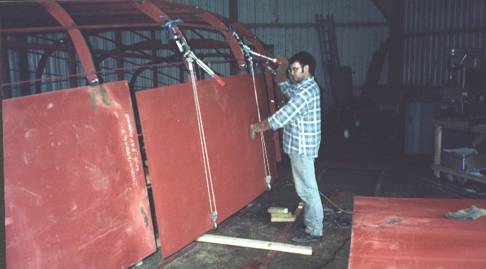Links
Fay Marine Photographs 4

Simple wire winches being used to lift and position a 4mm plate. A plate of this size and thickness is difficult to manoeuvre, even for two men without some sort of mechanical advantage.
These winches are relatively inexpensive and have many other uses, such as bending plates into position. There is a photo of that on the next page.
Note there are protective gloves, steel capped boots and also blocks of wood on the floor to take the edge. A sheet of steel will make a really good guillotine if it is not kept under control.

Using a sheet of 1/4" (6mm) plywood to template the bow plates. On many designs these are the hardest to pull into shape as they often have to be bent in two directions (compound curve). Making a template first helps enormously.
I template wherever the plate will be difficult to position, or where thicker plates are called for. This is normally the bow plates and often some of the keel plates which are normally 1/4" (6mm) or thicker and so really heavy and difficult to bend.
I have found that most other plates can be temporarily placed in position and marked to be cut with platers chalk.
This is where building upside down really pays as gravity does much of the work for you. Having a crane to turn the hull over seems a small price to pay.
 The
picture on the left shows how a simple lug cut from scrap angle iron can be tack
welded in place and then a pair of wood wedges used to locate the plate relative
to the chine bar or next plate.
The
picture on the left shows how a simple lug cut from scrap angle iron can be tack
welded in place and then a pair of wood wedges used to locate the plate relative
to the chine bar or next plate.
This is actually a 'T' bar chine with the web of the 'T' inside. It can be seen that this type of chine can be aesthetically pleasing. Once fully welded and the welds ground flat it gives a pleasantly soft turn to the chine.
ŠPaul Fay 2004